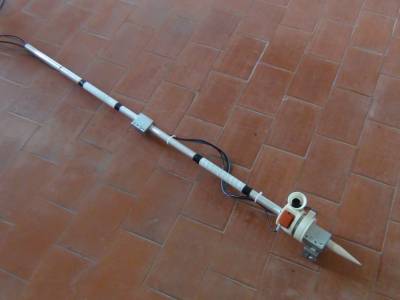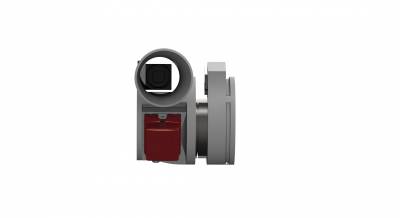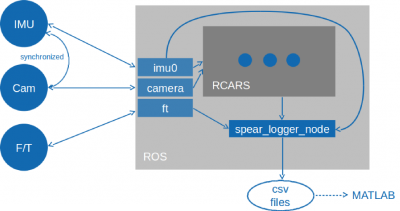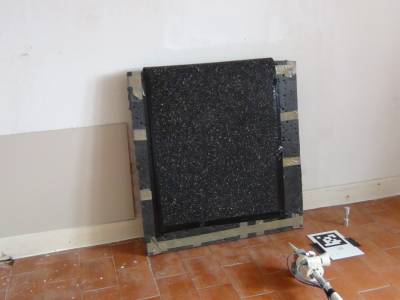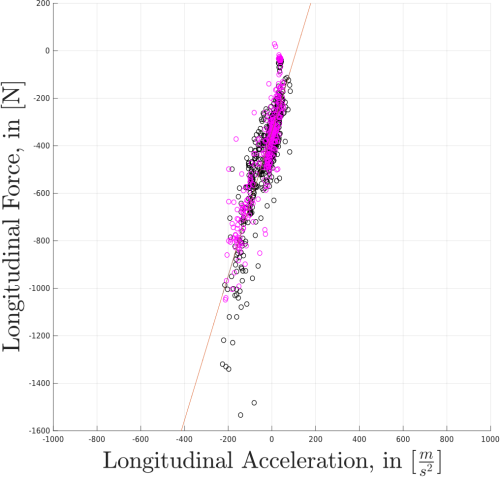Sidebar
<latex>{\fontsize{16pt}\selectfont \textbf{Monitoring a Spear Thrusting Task using Dynamic and Kinematic Sensors}} </latex>
<latex>{\fontsize{12pt}\selectfont \textbf{Constantin Herbst}} </latex>
<latex>{\fontsize{10pt}\selectfont \textit{Semester Thesis}} </latex>
<latex> {\fontsize{12pt}\selectfont \textbf{Abstract} </latex>
This project was conducted in cooperation with archaeologists from the Archaeological Research Center and Museum for Human Behavioral Evolution MONREPOS. The ar chaeological context for this project is an approximately 120.000 years old pelvis bone fragment from a fallow deer found in the site Neumark-Nord 1, Sachsen-Anhalt, Ger many. The bone features a penetration mark which is assumed to be of human origin. Considering angle and location of penetration, a thrusting spear suggests itself as a tool. It is the long-term goal of this project to find evidence for and against this hypothesis. This includes the compilation of well-documented reference bone wounds for purposes of comparative analysis. To achieve those goals, a spear-thrusting machine needs to be built, which allows for broad control of impact parameters such as impact velocity, angle, and applied external forces and torques. For constructing this machine knowledge of dynamic and kinematic characteristics of spear thrusting is required. In order to gain insight into the dynamics and kinematics of spear thrusting an instru mented spear was designed, built and used in various experiments. The experiments were: thrusting the spear at a fallow deer carcass (suspended and placed on the floor), at a target mat and at pig bones (scapula and pelvis) fixed in gelatin. The spear features a F/T transducer, an IMU and a video camera. Furthermore, RCARS, an open source state estimation system using AprilTags, was implemented for this setup. Thus, the experimental setup can measure forces and torques acting on the spear, as well as its acceleration, rotational velocity and its pose. These variables were recorded and anal- ysed, yielding a quantitative description of spear thrusting. Also, the bones struck and wounded in the course of the experiments were documented for later analysis.
<latex> {\fontsize{12pt}\selectfont \textbf{The Spear} </latex>
In short, the spear consists of a two-part aluminium tube shaft fixed to a holder for the sensors, which in turn is screwed to a clamp that receives the spear's tip. The sensors are connected to a computer running software allowing live monitoring and recording of measurements. The following sensors were used:
- A Force/Torque transducer (FT transducer),
- An Inertial Measurement Unit (IMU) and camera pair, for acceleration readings and sensor fusion pose estimation using RCARS 1).
During an internship preceding the semester thesis, most of the mechanical parts were designed. Design goals were mechanical robustness, especially of the sensor holder, quick (dis-)assembly and easy transport. The sensor holder was mostly 3D-printed, as this is much less costly than traditional production methods. However, this required careful mechanical design in order to ensure stability. A solution combining the strengths of 3D-printed parts and machined aluminium parts was found. Mechanical stresses are carried by metal parts, so that the plastic parts are subject only to pressure, and the plastic parts in turn only fix and protect the sensors.
<latex> {\fontsize{12pt}\selectfont \textbf{The Measurement Setup} </latex>
As a short overview, the quantities to be measured in the experiments are listed here:
- Forces and torques acting on the spear along all three spatial axes,
- The pose of the spear,
- The velocity at impact.
<latex> {\fontsize{12pt}\selectfont \textbf{The Experiments}} </latex>
Three different series of experiments were conducted:
- Thrust at a target mat,
- Thrust at a fallow deer carcass,
- Thrust at pig bones in gelatin.
The strikes were documented on video. During the strike, force, torque, acceleration and pose estimations were recorded. The entry wound, or strike mark, in the skin was photographed, if present. Spear tips made from different material (spruce and beech) were used. For each strike, tip material and the participant operating the spear were noted, together with information on the success of the strike (hit or miss, penetration of skin or no penetration, bone wound or no bone wound). In some instances, the tip was photographed after the strike.
<latex> {\fontsize{10pt}\selectfont \textbf{Target Mat}} </latex>
The goal of this series of experiments was to gather data on the influence of spear user related variables on spear thrusting. These variables are gender, height, age, weight and arm length. Secondly, the equipment was to be tested before performing the other experiments. The subjects were asked to perform following tasks, in this order:
- Strike the target mat with the spear,
- Three fast strikes,
- Strike and hold, i.e. strike the mat and apply pressure after striking, while the spear is still lodged in the mat.
The mat was a target mat used for archery, covered with a rubber mat to prevent complete penetration and severe damage to the mat.
<latex> {\fontsize{10pt}\selectfont \textbf{Fallow Deer Carcass}} </latex>
As the archaeological find is a pelvis bone from a fallow deer, a carcass of such an animal was used. This was done in order to recreate the bone wound found in the find. First the carcass was suspended using a wooden frame. The intention was to hoist the carcass in the pose in which its prehistoric counterpart was assumed to have had its bone wound struck. The suspension proved to be troublesome, though. As a dead animal has no muscle tension, very little counter force was experienced when striking. Also the movement of the carcass after striking caused practical problems. Since it was assumed that the prehistoric pelvis bone was struck at an acute angle, subjects tried to recreate this angle when striking the carcass. Due to limitations to the movement range and the inadequate suspension of the carcass, this proved to be difficult. Trying to recreate the bone wound of the find was abandoned. Instead, gathering data for statistics on spear striking itself became the goal. Multiple strikes were performed on different parts of the carcass. Also the idea of suspending the carcass was abandoned. The deer was lain on the floor, which prevents movement and also creates counter-force when striking. The participants were asked to strike the deer with as much force as possible in different locations. Multiple participants used the spear. Due to re-positioning the deer, the participants struck the deer with two different gestures (downwards and sidewards).
<latex> {\fontsize{10pt}\selectfont \textbf{Pig Bones in Gelatin}} </latex>
A number of difficulties presented itself as experiments were conducted on the deer carcass. The main problem was the detection of bone wounds after striking and assignment of these bone wounds to the corresponding flesh and skin wounds. Sometimes, different bone wounds may be corresponding to the same flesh wound, and vice versa. Also, locating the bones underneath skin and muscles was a problem. This made hitting specific bones difficult, especially since the bones could still move when the spear hit them. Bones were often hit and wounded multiple times. These problems made it impossible to gather a sufficient amount of well documented bone wounds and the corresponding data. All those problems lead to the conception and execution of another set of experiments, described in this section. In order to remedy the problems mentioned above, a number of pig bones already separated from their respective bodies were fixed in aluminium foil trays filled with gelatin. The transparency of gelatin allows for immediate detection of bone wounds. Furthermore, entry and exit wounds can be documented while the spear tip is still stuck in the bone, increasing the quality of documentation. Pelvis and scapula (shoulder) bones were chosen from the pig, due to their good availability. In contrast to the experiments above, only one participant used the spear.
<latex> {\fontsize{12pt}\selectfont \textbf{Results}} </latex>
Below an example timeseries is shown. The impact can be clearly distinguished as a (negative) peak in both force and acceleration curves. The acceleration of the spear before impact is also well identifiable.
 | The timeseries data for the acceleration measured in a bone in gelatin experiment. Highlighted from left to right: Initial sensor offset, acceleration phase, impact. |
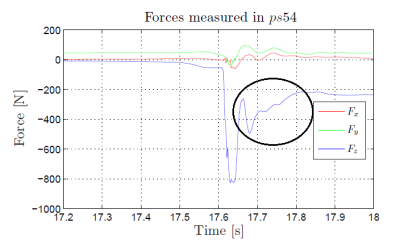 | The force timeseries for the same experiment. Highlighted is the period immediately after impact: The force measurements show that a pushing force is exerted by the user after impact. |
Using the features sketched in the figure above, the spear strike can be separated into acceleration, impact and holding phase. By integrating the acceleration measurements over the duration of the acceleration phase, the velocity of the spear at impact was calculated. But also the hold phase is interesting, since dynamic and static loading most likely result in different bone fractures. In order to differentiate the dynamic loads caused by the rapid slow down of mass and static loading by the user, a regression analysis was conducted.
<latex> {\fontsize{12pt}\selectfont \textbf{Conclusion}} </latex>
An instrumented spear setup was designed, built and used in various experiments. While there is room for improvement, it proved to be a feasible design. The experiments yielded enough data to extract a range of quantities characterizing spear thrusting. The spear thrusting task has been described in terms of velocity, mass and static forces. Considering the goal of constructing a spear thrusting machine, this quantitative characterization of spear thrust is pivotal. It has been shown that static forces applied through the spear user play a significant role during impact, which distinguishes the spear thrust from ballistic projectiles, such as arrows and javelins. This may cause different wound patterns, which is relevant to the long-term goal of this project.
A collection of well-documented bone wounds has been created, which contribute to the comparative analysis of similar archaeological finds.

